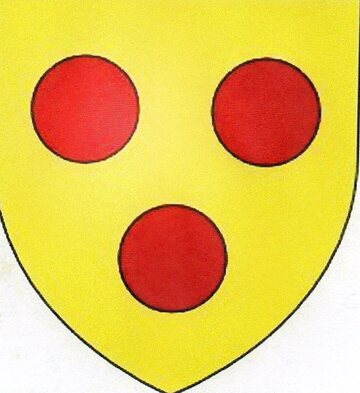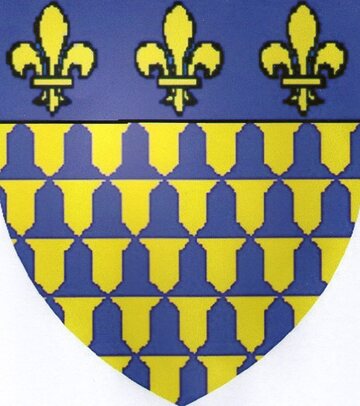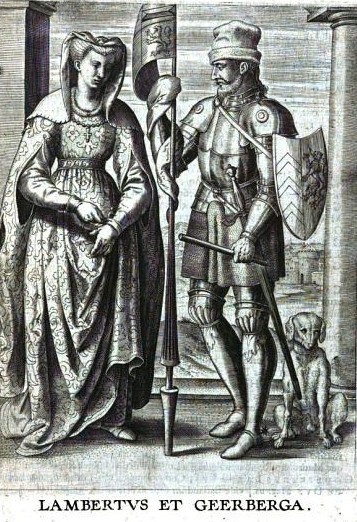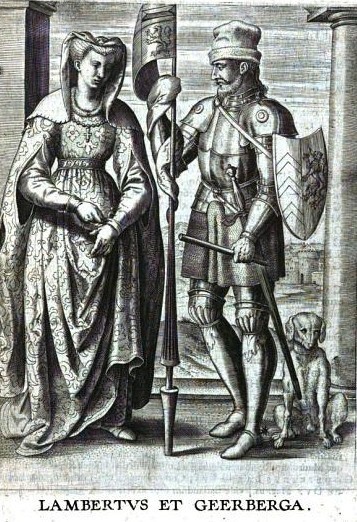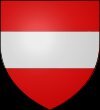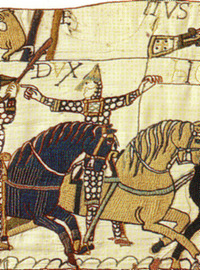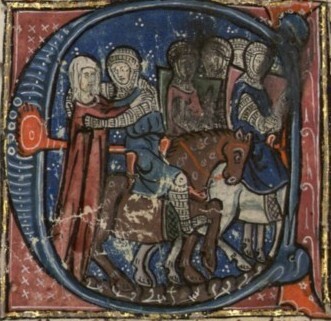maximum test » Eustace "count of Bologne" de Boulogne (1020-1087)
Personal data Eustace "count of Bologne" de Boulogne
Source 1- Nickname is count of Bologne.
- He was born in the year 1020 in Boulogne-sur-MerPas-de-Calais
France. Attention: Age at marriage (??-??-1031) below 16 years (11).
Attention: Age at marriage (??-??-1031) below 16 years (11). - Baptized (at 8 years of age or later) by the priesthood authority of the LDS church on November 21, 1947.
- Alternative: Baptized (at 8 years of age or later) by the priesthood authority of the LDS church on November 21, 1947.
- Alternative: Baptized (at 8 years of age or later) by the priesthood authority of the LDS church on November 21, 1947.
- Alternative: Baptized (at 8 years of age or later) by the priesthood authority of the LDS church on June 18, 1991 in JRIVE.
- Occupations:
- unknown in Count of Boulogne.
- Comte, de Boulogne, 1049, de Lens.
- Conde da Bolonha.
- He died in the year 1087, he was 67 years oldSpain.
- A child of Eustace de Boulogne and Mathilde de Louvain
Household of Eustace "count of Bologne" de Boulogne
He is married to Ida.
They got married in the year 1031, he was 11 years old.
Child(ren):
Notes about Eustace "count of Bologne" de Boulogne
GIVN II , Count Boulogne
SURN Eustache
REPO @REPO80@
TITL World Family Tree Vol. 11, Ed. 1
AUTH Brøderbund Software, Inc.
PUBL Release date: July 1, 1997
ABBR World Family Tree Vol. 11, Ed. 1
Customer pedigree.
Source Media Type: Family Archive CD
PAGE Tree #3804
DATA
TEXT Date of Import: 18 Dez 1998
REPO @REPO80@
TITL World Family Tree Vol. 11, Ed. 1
AUTH Brøderbund Software, Inc.
PUBL Release date: July 1, 1997
ABBR World Family Tree Vol. 11, Ed. 1
Customer pedigree.
Source Media Type: Family Archive CD
PAGE Tree #3804
DATA
TEXT Date of Import: 18 Dez 1998
REPO @REPO80@
TITL World Family Tree Vol. 11, Ed. 1
AUTH Brøderbund Software, Inc.
PUBL Release date: July 1, 1997
ABBR World Family Tree Vol. 11, Ed. 1
Customer pedigree.
Source Media Type: Family Archive CD
PAGE Tree #3804
DATA
TEXT Date of Import: 18 Dez 1998
DATE 9 SEP 2000
TIME 13:17:37
GIVN II , Count Boulogne
SURN Eustache
REPO @REPO80@
TITL World Family Tree Vol. 11, Ed. 1
AUTH Brøderbund Software, Inc.
PUBL Release date: July 1, 1997
ABBR World Family Tree Vol. 11, Ed. 1
Customer pedigree.
Source Media Type: Family Archive CD
PAGE Tree #3804
DATA
TEXT Date of Import: 18 Dez 1998
REPO @REPO80@
TITL World Family Tree Vol. 11, Ed. 1
AUTH Brøderbund Software, Inc.
PUBL Release date: July 1, 1997
ABBR World Family Tree Vol. 11, Ed. 1
Customer pedigree.
Source Media Type: Family Archive CD
PAGE Tree #3804
DATA
TEXT Date of Import: 18 Dez 1998
REPO @REPO80@
TITL World Family Tree Vol. 11, Ed. 1
AUTH Brøderbund Software, Inc.
PUBL Release date: July 1, 1997
ABBR World Family Tree Vol. 11, Ed. 1
Customer pedigree.
Source Media Type: Family Archive CD
PAGE Tree #3804
DATA
TEXT Date of Import: 18 Dez 1998
DATE 9 SEP 2000
TIME 13:17:37
Source #1: Frederick Lewis Weis, "Ancestral Roots of Certain American Colonists Who Came to America Before 1700" - Seventh Edition, with additions and corrections by Walter Lee Sheppard, Jr., assisted by Davis Faris (Baltimore, MD: Genealogical Publishing Co, 1995), p. 138
A companion of William the Conqueror, at the Battle of Hastings, 1066.
Name Prefix:Count Name Suffix: Of Boulogne
companion of William I at Battle of Hastings
Eustace II of Boulogne
From Wikipedia, the free encyclopedia
Eustace II, (c. 1015-1020 – 1087) [1][2] was count of Boulogne from 1049-1093, fought on the Norman side at the Battle of Hastings, and afterwards received a large honour in England.
He was the son of Eustace I. His first wife was Goda, daughter of the English king Æthelred the Unready, and sister of Edward the Confessor.[3] Goda died in 1055, before the Norman Conquest of her homeland, in which her husband participated. From his second marriage with Ida of Lorraine (daughter of Godfrey III, Duke of Lower Lorraine), Eustace had three sons, Eustace III, the next count of Boulogne, and Godfrey of Bouillon and Baldwin, both later monarchs of Jerusalem.
In 1048 Eustace joined his father-in-law's rebellion against the Emperor Henry III. The next year Eustace was excommunicated by Pope Leo IX for marrying within the prohibited degree of kinship[4]. It's likely the pope's action was at the behest of Henry III. The rebellion failed, and in 1049 Eustance and Godfrey submitted to Henry III.
Eustace paid a visit to England in 1051, and was honourably received at the Confessor's court. Edward and Eustace were former brothers-in-law and remained allied politically. On the other hand the dominant figure in England, Earl Godwin, had recently married his son Tostig to the daughter of Eustace's rival the count of Flanders. Furthermore Godwin's son Sweyn had been feuding with Eustace's stepson Ralph the Timid.
A brawl in which Eustace and his servants became involved with the citizens of Dover led to a serious quarrel between the king and Godwin. The latter, to whose jurisdiction the men of Dover were subject, refused to punish them. His lack of respect to those in authority was made the excuse for outlawing himself and his family. They left England, but returned the next year (1052) with a large army, aided by the Flemish.
In 1052 William of Talou rebelled against his nephew William of Normandy. Eustace may well have been involved in this rebellion, although there is no specific evidence, for after William of Talou's surrender he fled to the Boulonnais court.
The following years saw still further advances by Eustace's rivals and enemies. Count Baldwin of Flanders consolidated his hold over territories he had annexed to the east. In 1060 he became regent of France during the minority of his nephew Philip I of France. In contrast Eustace's stepson Walter of Mantes failed in his attempt to claim the County of Maine. He was captured by the Normans and died soon afterwards in mysterious circumstances.
These events evidently caused a shift in Eustace political allegiances, for he then became an important participant in the Norman conquest of England in 1066. He fought at Hastings, although sources vary regarding the details of his conduct during the battle. Eustace received large land grants afterwards, which suggests he contributed in other ways as well, perhaps by providing ships.
In the following year, probably because he was dissatisfied with his share of the spoil, he assisted the Kentishmen in an attempt to seize Dover Castle. The conspiracy failed, and Eustace was sentenced to forfeit his English fiefs.
Subsequently he was reconciled to the Conqueror, who restored a portion of the confiscated lands.
Eustace died in 1093, and was succeeded by his son, Eustace III.
It has been suggested that Eustace was the patron of the Bayeux Tapestry.[5]
[edit] Notes
* This article incorporates text from the Encyclopædia Britannica Eleventh Edition, a publication now in the public domain.
1. ^ Tanner, Heather. "The Expansion of the Power and Influence of the Counts of Boulogne under Eustace II". Anglo-Norman Studies 14: 251-277.
2. ^ NORTHERN FRANCE, NOBILITY. Retrieved on 2007-11-04. NORTHERN FRANCE, NOBILITY presents a range of dates for both his birth and death. Encyclopædia Britannica Eleventh Edition appears to favor a 1087 death date. This conflicts with the previous source and with Holböck, Ferdinand (c. 2002). Married Saints and Blesseds. Ignatius Press, p. 147. ISBN 0898708435. and Duby, Georges; Jane Dunnett, translator (c. 1996). Love and Marriage in the Middle Ages. University of Chicago Press: Ignatius Press, p. 40. ISBN 0226167747.
3. ^ Vitalis, Ordericus; Thomas Forester, translator (1854). The Ecclesiastical History of England and Normandy, Vol II. London: H.G. Bohn, p. 12, footnote.
4. ^ Tanner 263. Eustace and Ida were both descended from Louis II of France, and just within the prohibited seventh degree. However, since today we don't know all their ancestors, it's possible there was a closer relationship.
5. ^ Bridgeford
[edit] References
* Bridgeford, Andrew (1999). "Was Count Eustace II of Boulogne the patron of the Bayeux Tapestry?". Journal of Medieval History 25: 155-185.?; Bridgeford, Andrew (2005). 1066: The Hidden History in the Bayeux Tapestry. Walker & Company. ISBN 1841150401. ; Bridgeford, Andrew (2004). "Whose Tapestry is it Anyway?". History Today 54.?
* Tanner, Heather. "The Expansion of the Power and Influence of the Counts of Boulogne under Eustace II". Anglo-Norman Studies 14: 251-277.?
* Vitalis, Ordericus; Thomas Forester, translator (1854). The Ecclesiastical History of England and Normandy, Vol II. London: H. G. Bohn, p. 12, footnote.
* Foundation of Medieval Genealogy.
* Holböck, Ferdinand (c. 2002). Married Saints and Blesseds. Ignatius Press, p. 147. ISBN 0898708435.
* Duby, Georges; Jane Dunnett, translator (c. 1996). Love and Marriage in the Middle Ages. University of Chicago Press: Ignatius Press, p. 40. ISBN 0226167747.
Preceded by
Eustace I Count of Boulogne
1049–1070 Succeeded by
Eustace III
[Weis 138] a companion of William I, the Conqueror (121-24), at the battle of Hastings, 1066.
I do not have verification on all information that you have downloaded. Please feel free to contact me @ (XXXXX@XXXX.XXX) for errors/corrections/ or any additional information, especially if you are willing to share information
I do not have verification on all information that you have downloaded. Please feel free to contact me @ (XXXXX@XXXX.XXX) for errors/corrections/ or any additional information, especially if you are willing to share information
Count Eustace was the eldest son of Eustace "with the Eye," Count of Boulogne, by his wife Mahaut, daughter of Lambert the Bearded, Count of Louvain, and was a sovereign prince in his own county, owing no superior save his lord the King of France. His house had been founded by Angilbert, a Frank noble, who married Bertha, daughter of the Emperor Charlemagne, and before 790 was created Duke of the maritime territory, afterwards styled Ponthieu. (Art. de Verifier les Dates, xii., 318). In 1050 he had married Godgifu or Goda, the sister of Edward the Confessor; and the following year came over with a great train to visit his brother-in-law. As he was passing through Dover on his way home, one of his followers quarrelled with a townsman about his quarters, and killed him on the spot. The whole town flew to arms, and the Count and his retainers had to fight for their lives against desperate odds, only escaping at last with the loss of upwards of twenty men. The King took their part, and called upon the Earl of Kent to punish the men of Dover, but Godwin, jealous of the favour shown to the foreigners, refused to interfere unless both parties were brought to trial, demanding that Eustace and his men-at-arms should be delivered up to him. This dispute, prolonged and embittered by much exasperating altercation, lead to the banishment of Earl Godwin and his family. By a strange irony of fate, when the men of Kent rose against the stern rule of Bishop Odo in 1067, it was their ancient foeman Count Eustace that they summoned to their aid; and he brought over a French force that made an unsuccessful attempt to seize Dover Castle. For this he was, according to ancient form, arraigned for high treason before the King and his Witan; but contrived to make his peace, and continued high in William's favour till his death. His English wife, who had given him no children, died about 1054; and two years later, in passing through Lower Lorraine, on his return from escorting Pope Victor II. to Rome, he was entertained by Duke Godfrey at Bouillon, and fell in love with his daughter Ida.
companion of William I at Battle of Hastings
Eustace is described as a companion of William the Conqueror at the ba ttle of Hastings. Eustace II, (d. 1093), count of Boulogne, was the h usband of Goda, daughter of the English king Æthelred the Unready, an d sister of Edward the Confessor. He was the son of Eustace I. From hi s second marriage with Ida of Lorraine, Eustace had three sons, Eustac e III, the next count of Boulogne, and Godfrey of Bouillon and Baldwin , both later monarchs of Jerusalem in Syria.
Eustace paid a visit to England in 1051, and was honourably received a t the Confessor's court. A brawl in which he and his servants became i nvolved with the citizens of Dover led to a serious quarrel between th e king and Earl Godwine. The latter, to whose jurisdiction the men o f Dover were subject, refused to punish them. His lack of respect to t hose in authority was made the excuse for outlawing himself and his fa mily. He suceeded his brother Lambert as Count of Lens after 1054. In 1066 Eustace came to England with Duke William, and fought at the batt le of Hastings, and received properties in England. By 1087, Eustace had spent much of the Conquerors reign in Boulogne. In 1088, Eustace participated, with Odo of Bayeus and Robert of Mortain and six of Engl ands wealthiest magnates in an attempt to remove William Rufus from th e throne in favor of Robert Curthose. Later that year, he was disseis ed by Rufus.
In the following year, probably because he was dissatisfied with his s hare of the spoil, he assisted the Kentishmen in an attempt to seize D over Castle. The conspiracy failed, and Eustace was sentenced to forfe it his English fiefs. Subsequently he was reconciled to the Conqueror , who restored a portion of the confiscated lands. Eustace died in 10 93, and was succeeded by his son, Eustace III.
GIVN II , Count Boulogne
SURN Eustache
REPO @REPO80@
TITL World Family Tree Vol. 11, Ed. 1
AUTH Brøderbund Software, Inc.
PUBL Release date: July 1, 1997
ABBR World Family Tree Vol. 11, Ed. 1
Customer pedigree.
Source Media Type: Family Archive CD
PAGE Tree #3804
DATA
TEXT Date of Import: 18 Dez 1998
REPO @REPO80@
TITL World Family Tree Vol. 11, Ed. 1
AUTH Brøderbund Software, Inc.
PUBL Release date: July 1, 1997
ABBR World Family Tree Vol. 11, Ed. 1
Customer pedigree.
Source Media Type: Family Archive CD
PAGE Tree #3804
DATA
TEXT Date of Import: 18 Dez 1998
REPO @REPO80@
TITL World Family Tree Vol. 11, Ed. 1
AUTH Brøderbund Software, Inc.
PUBL Release date: July 1, 1997
ABBR World Family Tree Vol. 11, Ed. 1
Customer pedigree.
Source Media Type: Family Archive CD
PAGE Tree #3804
DATA
TEXT Date of Import: 18 Dez 1998
DATE 9 SEP 2000
TIME 13:17:37
#Générale##Générale#Profession : Comte de Boulogne et de Lens.
{geni:about_me} http://en.wikipedia.org/wiki/Eustace_II_of_Boulogne
--------------------
http://en.wikipedia.org/wiki/Eustace_II,_Count_of_Boulogne
--------------------
From Wikipedia:
Eustace II, (c. 1015-1020 – c. 1087) [1][2] was count of Boulogne from 1049-1087, fought on the Norman side at the Battle of Hastings, and afterwards received a large honour in England.
He was the son of Eustace I. His first wife was Goda, daughter of the English king Æthelred the Unready, and sister of Edward the Confessor. Goda died circa 1047[4], and he quickly married again (about 1049). From his second marriage with Ida of Lorraine (daughter of Godfrey III, Duke of Lower Lorraine), Eustace had three sons, Eustace III, the next count of Boulogne, and Godfrey of Bouillon and Baldwin, both later monarchs of Jerusalem.
Note: His son Geoffrey is from a second short marriage that ended in divorce.
--------------------
-https://fmg.ac/Projects/MedLands/NORTHERN%20FRANCE.htm#EustacheIIB
EUSTACHE [II] "Gernobadatus" de Boulogne, son of EUSTACHE [I] Comte de Boulogne & his wife Mathilde de Louvain ([1015/20]-[soon after 1070/1087]). The Genealogica comitum Buloniensium records that "Eustachium et Lantbertum" were sons of "comes Eustachius de Bolonia" and his wife Mathilde[724]. His birth date range is estimated from the date of his first marriage, and bearing in mind the estimated birth date range of his mother. He succeeded his father in [1049] as Comte de Boulogne. Simeon of Durham records that "Eustace the elder earl of Boulogne who had married king Eadward's sister Goda" landed at Dover in Sep 1051[725]. When returning from visiting Edward "the Confessor" King of England in 1051, he was involved in an affray at Canterbury during which one of his men was killed. The refusal of Godwin Earl of Wessex to punish the offenders led to the Earl's temporary banishment from England[726]. Comte de Lens 1054. "Eustatii comitis" witnessed a charter of "Balduinus Flandrensium comes" dated 6 Jan 1056[727]. Orderic Vitalis records that “Eustachium comitem” was seriously wounded during the battle of Hastings but escaped “quasi moribundus”[728]. He was awarded a large fief "the honour of Boulogne"[729], but soon quarrelled with William I King of England. He launched an attack on England in 1067, but withdrew after landing. His English lands were confiscated, but later restored. Boulogne's strategic importance grew as it became the main port for importing English wool for the Flemish cloth trade.
'''m''' firstly ([1036]) as her second husband, GODGIFU [Goda] of England, widow of DREUX [Drogo] Comte de Mantes et du Vexin, daughter of ÆTHELRED II King of England & his second wife Emma de Normandie (-before 1049). Her parentage is recorded by Orderic Vitalis, who says that she went into exile in Normandy with her brother[730], which can be dated from other sources to 1013. Her first marriage was arranged by Robert II Duke of Normandy[731], indicating that she probably did not return to England. Her second marriage is referred to by Florence of Worcester[732]. Simeon of Durham records that "Eustace the elder earl of Boulogne who had married king Eadward's sister Goda" landed at Dover in Sep 1051[733].
'''m''' secondly IDA of Lotharingia, daughter of GODEFROI Duke of Upper Lorraine Comte de Verdun & his first wife Doda [de Rethel] ([1038/43][734]-13 Aug 1113). Her marriage is recorded by Orderic Vitalis, who specifies that she was the sister of "Godfrey Duke of Lotharingia" and names her three sons[735]. The Vita B. Idæ Boloniensis Comitissæ records that she was the daughter of "pater…Godefridus, mater…Doda"[736]. She made a donation to Saint-Bertin for the soul of "Eustachii domini mei comitis" with her sons "Godefridi et Balduini"[737]. The Lamberti Audomariensis Chronica records the death "Id Apr 1113" of "Ida comitissa Boloniæ"[738].
Come Eustache [II] & his second wife had [four] children:
------------------
-----------------
--------------------
Eustace II, (c. 1015-1020 – 1087) was count of Boulogne from 1049-1093, fought on the Norman side at the Battle of Hastings, and afterwards received a large honour in England.
He was the son of Eustace I. His first wife was Goda, daughter of the English king Æthelred the Unready, and sister of Edward the Confessor. Goda died in 1055, before the Norman Conquest of her homeland, in which her husband participated. From his second marriage with Ida of Lorraine (daughter of Godfrey III, Duke of Lower Lorraine), Eustace had three sons, Eustace III, the next count of Boulogne, and Godfrey of Bouillon and Baldwin, both later monarchs of Jerusalem.
In 1048 Eustace joined his father-in-law's rebellion against the Emperor Henry III. The next year Eustace was excommunicated by Pope Leo IX for marrying within the prohibited degree of kinship. It's likely the pope's action was at the behest of Henry III. The rebellion failed, and in 1049 Eustance and Godfrey submitted to Henry III.
Eustace paid a visit to England in 1051, and was honourably received at the Confessor's court. Edward and Eustace were former brothers-in-law and remained allied politically. On the other hand the dominant figure in England, Earl Godwin, had recently married his son Tostig to the daughter of Eustace's rival the count of Flanders. Furthermore Godwin's son Sweyn had been feuding with Eustace's stepson Ralph the Timid.
A brawl in which Eustace and his servants became involved with the citizens of Dover led to a serious quarrel between the king and Godwin. The latter, to whose jurisdiction the men of Dover were subject, refused to punish them. His lack of respect to those in authority was made the excuse for outlawing himself and his family. They left England, but returned the next year (1052) with a large army, aided by the Flemish.
In 1052 William of Talou rebelled against his nephew William of Normandy. Eustace may well have been involved in this rebellion, although there is no specific evidence, for after William of Talou's surrender he fled to the Boulonnais court.
The following years saw still further advances by Eustace's rivals and enemies. Count Baldwin of Flanders consolidated his hold over territories he had annexed to the east. In 1060 he became regent of France during the minority of his nephew Philip I of France. In contrast Eustace's stepson Walter of Mantes failed in his attempt to claim the County of Maine. He was captured by the Normans and died soon afterwards in mysterious circumstances.
These events evidently caused a shift in Eustace political allegiances, for he then became an important participant in the Norman conquest of England in 1066. He fought at Hastings, although sources vary regarding the details of his conduct during the battle. Eustace received large land grants afterwards, which suggests he contributed in other ways as well, perhaps by providing ships.
In the following year, probably because he was dissatisfied with his share of the spoil, he assisted the Kentishmen in an attempt to seize Dover Castle. The conspiracy failed, and Eustace was sentenced to forfeit his English fiefs.
Subsequently he was reconciled to the Conqueror, who restored a portion of the confiscated lands.
Eustace died in 1093, and was succeeded by his son, Eustace III.
It has been suggested that Eustace was the patron of the Bayeux Tapestry.
--------------------
Eustace II, (c. 1015-1020 – 1087) was count of Boulogne from 1049-1093, fought on the Norman side at the Battle of Hastings, and afterwards received a large honour in England.
He was the son of Eustace I. His first wife was Goda, daughter of the English king Æthelred the Unready, and sister of Edward the Confessor. Goda died in 1055, before the Norman Conquest of her homeland, in which her husband participated. From his second marriage with Ida of Lorraine (daughter of Godfrey III, Duke of Lower Lorraine), Eustace had three sons, Eustace III, the next count of Boulogne, and Godfrey of Bouillon and Baldwin, both later monarchs of Jerusalem.
In 1048 Eustace joined his father-in-law's rebellion against the Emperor Henry III. The next year Eustace was excommunicated by Pope Leo IX for marrying within the prohibited degree of kinship. It's likely the pope's action was at the behest of Henry III. The rebellion failed, and in 1049 Eustance and Godfrey submitted to Henry III.
Eustace paid a visit to England in 1051, and was honourably received at the Confessor's court. Edward and Eustace were former brothers-in-law and remained allied politically. On the other hand the dominant figure in England, Earl Godwin, had recently married his son Tostig to the daughter of Eustace's rival the count of Flanders. Furthermore Godwin's son Sweyn had been feuding with Eustace's stepson Ralph the Timid.
A brawl in which Eustace and his servants became involved with the citizens of Dover led to a serious quarrel between the king and Godwin. The latter, to whose jurisdiction the men of Dover were subject, refused to punish them. His lack of respect to those in authority was made the excuse for outlawing himself and his family. They left England, but returned the next year (1052) with a large army, aided by the Flemish.
In 1052 William of Talou rebelled against his nephew William of Normandy. Eustace may well have been involved in this rebellion, although there is no specific evidence, for after William of Talou's surrender he fled to the Boulonnais court.
The following years saw still further advances by Eustace's rivals and enemies. Count Baldwin of Flanders consolidated his hold over territories he had annexed to the east. In 1060 he became regent of France during the minority of his nephew Philip I of France. In contrast Eustace's stepson Walter of Mantes failed in his attempt to claim the County of Maine. He was captured by the Normans and died soon afterwards in mysterious circumstances.
These events evidently caused a shift in Eustace political allegiances, for he then became an important participant in the Norman conquest of England in 1066. He fought at Hastings, although sources vary regarding the details of his conduct during the battle. Eustace received large land grants afterwards, which suggests he contributed in other ways as well, perhaps by providing ships.
In the following year, probably because he was dissatisfied with his share of the spoil, he assisted the Kentishmen in an attempt to seize Dover Castle. The conspiracy failed, and Eustace was sentenced to forfeit his English fiefs.
Subsequently he was reconciled to the Conqueror, who restored a portion of the confiscated lands.
Eustace died in 1093, and was succeeded by his son, Eustace III.
It has been suggested that Eustace was the patron of the Bayeux Tapestry.
--------------------
http://en.wikipedia.org/wiki/Eustace_II,_Count_of_Boulogne
Eustace II, (c. 1015-1020 – c. 1087) [1][2] was count of Boulogne from 1049-1087, fought on the Norman side at the Battle of Hastings, and afterwards received a large honour in England. He is one of the few proven Companions of William the Conqueror.
He was the son of Eustace I. His first wife was Goda, daughter of the English king Æthelred the Unready, and sister of Edward the Confessor.[3] Goda died circa 1047[4], and he quickly married again (about 1049[4]). From his second marriage with Ida of Lorraine (daughter of Godfrey III, Duke of Lower Lorraine), Eustace had three sons, Eustace III, the next count of Boulogne, and Godfrey of Bouillon and Baldwin, both later monarchs of Jerusalem.
In 1048 Eustace joined his father-in-law's rebellion against the Emperor Henry III. The next year Eustace was excommunicated by Pope Leo IX for marrying within the prohibited degree of kinship[5]. It's likely the pope's action was at the behest of Henry III. The rebellion failed, and in 1049 Eustace and Godfrey submitted to Henry III.
Eustace paid a visit to England in 1051, and was honourably received at the Confessor's court. Edward and Eustace were former brothers-in-law and remained allied politically. On the other hand the dominant figure in England, Earl Godwin, had recently married his son Tostig to the daughter of Eustace's rival the count of Flanders. Furthermore Godwin's son Sweyn had been feuding with Eustace's stepson Ralph the Timid.
A brawl in which Eustace and his servants became involved with the citizens of Dover led to a serious quarrel between the king and Godwin. The latter, to whose jurisdiction the men of Dover were subject, refused to punish them. His lack of respect to those in authority was made the excuse for outlawing himself and his family. They left England, but returned the next year (1052) with a large army, aided by the Flemish.
In 1052 William of Talou rebelled against his nephew William of Normandy. Eustace may well have been involved in this rebellion, although there is no specific evidence, for after William of Talou's surrender he fled to the Boulonnais court.
The following years saw still further advances by Eustace's rivals and enemies. Count Baldwin of Flanders consolidated his hold over territories he had annexed to the east. In 1060 he became tutor of his nephew Philip I of France. In contrast Eustace's stepson Walter of Mantes failed in his attempt to claim the County of Maine. He was captured by the Normans and died soon afterwards in mysterious circumstances.
These events evidently caused a shift in Eustace's political allegiances, for he then became an important participant in the Norman conquest of England in 1066. He fought at Hastings, although sources vary regarding the details of his conduct during the battle. Sources suggest that Eustace was present, with William the Bastard at the Malfosse incident in the immediate aftermath of the battle, where a Saxon, feigning death leapt up and attacked him, and was presumably cut down before he could reach William.
Eustace received large land grants afterwards, which suggests he contributed in other ways as well, perhaps by providing ships.
In the following year, probably because he was dissatisfied with his share of the spoil, he assisted the Kentishmen in an attempt to seize Dover Castle. The conspiracy failed, and Eustace was sentenced to forfeit his English fiefs.
Subsequently he was reconciled to the Conqueror, who restored a portion of the confiscated lands.
Eustace died circa 1087, and was succeeded by his son, Eustace III.
It has been suggested that Eustace was the patron of the Bayeux Tapestry.[6]
Eustace has been portrayed on screen by Leslie Bradley in the film Lady Godiva of Coventry (1955) and by Joby Blanshard in the two-part BBC TV play Conquest (1966), part of the series Theatre 625.
--------------------
Has a wikipedia page - http://en.wikipedia.org/wiki/Eustace_II,_Count_of_Boulogne
--------------------
http://en.wikipedia.org/wiki/Eustace_II,_Count_of_Boulogne
Eustace II, (c. 1015-1020 – c. 1087) was count of Boulogne from 1049-1087, fought on the Norman side at the Battle of Hastings, and afterwards received a large honour in England. He is one of the few proven Companions of William the Conqueror.
He was the son of Eustace I. His first wife was Goda, daughter of the English king Æthelred the Unready, and sister of Edward the Confessor. Goda died circa 1047, and he quickly married again (about 1049). From his second marriage with Ida of Lorraine (daughter of Godfrey III, Duke of Lower Lorraine), Eustace had three sons, Eustace III, the next count of Boulogne, and Godfrey of Bouillon and Baldwin, both later monarchs of Jerusalem.
In 1048 Eustace joined his father-in-law's rebellion against the Emperor Henry III. The next year Eustace was excommunicated by Pope Leo IX for marrying within the prohibited degree of kinship. It's likely the pope's action was at the behest of Henry III. The rebellion failed, and in 1049 Eustace and Godfrey submitted to Henry III.
Eustace paid a visit to England in 1051, and was honourably received at the Confessor's court. Edward and Eustace were former brothers-in-law and remained allied politically. On the other hand the dominant figure in England, Earl Godwin, had recently married his son Tostig to the daughter of Eustace's rival the count of Flanders. Furthermore Godwin's son Sweyn had been feuding with Eustace's stepson Ralph the Timid.
A brawl in which Eustace and his servants became involved with the citizens of Dover led to a serious quarrel between the king and Godwin. The latter, to whose jurisdiction the men of Dover were subject, refused to punish them. His lack of respect to those in authority was made the excuse for outlawing himself and his family. They left England, but returned the next year (1052) with a large army, aided by the Flemish.
In 1052 William of Talou rebelled against his nephew William of Normandy. Eustace may well have been involved in this rebellion, although there is no specific evidence, for after William of Talou's surrender he fled to the Boulonnais court.
The following years saw still further advances by Eustace's rivals and enemies. Count Baldwin of Flanders consolidated his hold over territories he had annexed to the east. In 1060 he became tutor of his nephew Philip I of France. In contrast Eustace's stepson Walter of Mantes failed in his attempt to claim the County of Maine. He was captured by the Normans and died soon afterwards in mysterious circumstances.
These events evidently caused a shift in Eustace's political allegiances, for he then became an important participant in the Norman conquest of England in 1066. He fought at Hastings, although sources vary regarding the details of his conduct during the battle. Sources suggest that Eustace was present, with William the Bastard at the Malfosse incident in the immediate aftermath of the battle, where a Saxon, feigning death leapt up and attacked him, and was presumably cut down before he could reach William.
Eustace received large land grants afterwards, which suggests he contributed in other ways as well, perhaps by providing ships.
In the following year, probably because he was dissatisfied with his share of the spoil, he assisted the Kentishmen in an attempt to seize Dover Castle. The conspiracy failed, and Eustace was sentenced to forfeit his English fiefs.
Subsequently he was reconciled to the Conqueror, who restored a portion of the confiscated lands.
Eustace died circa 1087, and was succeeded by his son, Eustace III.
It has been suggested that Eustace was the patron of the Bayeux Tapestry.
Eustace has been portrayed on screen by Leslie Bradley in the film Lady Godiva of Coventry (1955) and by Joby Blanshard in the two-part BBC TV play Conquest (1966), part of the series Theatre 625.
[FAVthomas.FTW]
A companion of William the Conqueror at the Battle of Hastings, 1066.
from "Our Folk" by Albert D Hart, Jr.
!SOURCES:
1. Putnam Lineage
2. Peerage and Family History Eng. 151 p. 172
!SOURCES:
1. Putnam Lineage
2. Peerage and Family History Eng. 151 p. 172
!SOURCES:
1. Putnam Lineage
2. Peerage and Family History Eng. 151 p. 172
Ancestral File Number:9QVV-NJ
Ancestral File Number:9QVV-NJ
Ancestral File Number:V9SZ-76
COUNT (OR EARL) OF BULLEINE (BOLOGNE); ACCOMPANIED WILLIAM THE CONQUEROR TO
ENGLAND
!SOURCES:
1. Putnam Lineage
2. Peerage and Family History Eng. 151 p. 172
He was killed at the Battle of Hastings in 1066.
He was killed at the Battle of Hastings in 1066.
!SOURCES:
1. Putnam Lineage
2. Peerage and Family History Eng. 151 p. 172
Timeline Eustace "count of Bologne" de Boulogne
This functionality is only available in Javascript supporting browsers.
Click on the names for more info.
Symbols used:  grandparents
grandparents
 parents
parents
 brothers/sisters
brothers/sisters
 children
children
 grandparents
grandparents
 parents
parents
 brothers/sisters
brothers/sisters
 children
children
Sources
Matches in other publications
This person also appears in the publication:Historical events
Christening day June 18, 1991
- The temperature on June 18, 1991 was between 8.9 °C and 15.4 °C and averaged 11.8 °C. There was 6.3 mm of rain during 3.3 hours. There was 3.2 hours of sunshine (19%). The heavily clouded was. The average windspeed was 2 Bft (weak wind) and was prevailing from the west-southwest. Source: KNMI
- Koningin Beatrix (Huis van Oranje-Nassau) was from April 30, 1980 till April 30, 2013 sovereign of the Netherlands (also known as Koninkrijk der Nederlanden)
- In The Netherlands , there was from Tuesday, November 7, 1989 to Monday, August 22, 1994 the cabinet Lubbers III, with Drs. R.F.M. Lubbers (CDA) as prime minister.
- In the year 1991: Source: Wikipedia
- The Netherlands had about 15.0 million citizens.
- April 2 » Rita Johnston becomes the first female Premier of a Canadian province when she succeeds William Vander Zalm (who had resigned) as Premier of British Columbia.
- April 10 » A rare tropical storm develops in the South Atlantic Ocean near Angola; the first to be documented by satellites.
- May 26 » Lauda Air Flight 004 breaks apart in mid-air and crashes in the Phu Toei National Park in Thailand, killing all 223 people on board.
- June 26 » Yugoslav Wars: The Yugoslav People's Army begins the Ten-Day War in Slovenia.
- September 6 » The Soviet Union recognizes the independence of the Baltic states Estonia, Latvia, and Lithuania.
- September 17 » The first version of the Linux kernel (0.01) is released to the Internet.
About the surname De Boulogne
- View the information that Genealogie Online has about the surname De Boulogne.
- Check the information Open Archives has about De Boulogne.
- Check the Wie (onder)zoekt wie? register to see who is (re)searching De Boulogne.
The maximum test publication was prepared by Ard van Bergen.
When copying data from this family tree, please include a reference to the origin:
Ard van Bergen, "maximum test", database, Genealogy Online (https://www.genealogieonline.nl/maximum-test/I6000000002215326285.php : accessed June 4, 2024), "Eustace "count of Bologne" de Boulogne (1020-1087)".
Ard van Bergen, "maximum test", database, Genealogy Online (https://www.genealogieonline.nl/maximum-test/I6000000002215326285.php : accessed June 4, 2024), "Eustace "count of Bologne" de Boulogne (1020-1087)".
